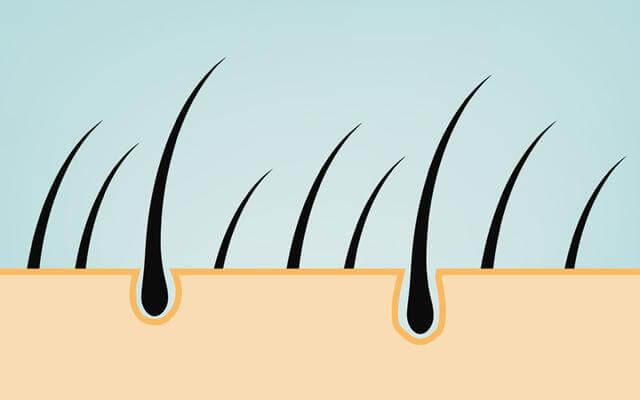
As men grow older, many of them will develop hair loss in a characteristic pattern. It can start at the frontal scalp, moving upwards on the sides (‘bitemporal’), or at the back/top of the head at an area called the crown (also ‘vertex’). This hair loss progressively continues up to the mid scalp. Hair on the sides of the head and below the crown at the back are spared (the ‘occipital region’). This pattern of hair loss is known as male-pattern hair loss or androgenetic alopecia.
Androgenetic alopecia has the word ‘androgen’ in it, and with good reason. A phenomenal paper published in 1942 dubbed “Male hormone stimulation is prerequisite and an incitant in common baldness” [1] eloquently addresses the link between androgens and androgenetic alopecia. As you’ve probably derived from the name of the paper, the condition was then still dubbed “common baldness”. The author made some keen observations. First, the author observed that eunuchs and prepubertally castrated men didn’t develop alopecia. He writes: “Even the recession of the line of hair on the temples and foreheads which is observed in the majority of normal men failed to appear.” Second, when given testosterone, some of the men developed hair loss. Interestingly, when two of these men discontinued testosterone therapy for a year, baldness stopped to progress. However, when they were put back on testosterone again, the progression of hair loss resumed. Third, he also observed that the men who developed alopecia upon androgenic treatment belonged to families in which normal adult male members tend to be bald. Similarly, those who didn’t develop alopecia belonged to families without pronounced tendencies to baldness among the normal men. As such, a genetic predisposition to alopecia is suspected.
A paper published in the journal Science in 1974 demonstrated the pivotal role of dihydrotestosterone (DHT) in mediating testosterone’s effect on this condition [2]. DHT is a metabolite of testosterone that is formed by the 5α-reductase family of enzymes. DHT is a more potent androgen than testosterone, and thus testosterone’s effect is amplified in tissues expressing these enzymes. It was found that subjects with a 5α-reductase deficiency didn’t develop recession of their hairline. Indeed, a later review paper mentions that androgenetic alopecia has never been observed in people with this condition [3].
The important role of genetics in developing androgenetic alopecia is underscored in a twin study examining physical aging and longevity [4]. 76 identical twin pairs (monozygotic twins) participated, of which 65 (42 male, 23 female) also were included in the analysis of hair loss. A smaller sample of 21 nonidentical twin pairs (dizygotic twins) also participated, of which 16 were included in the analysis of hair loss (14 male, 2 female).The researchers then graded the difference in hair loss (baldness) between the pairs as ‘none’, ‘slight’, or ‘striking’. The results were as follows:
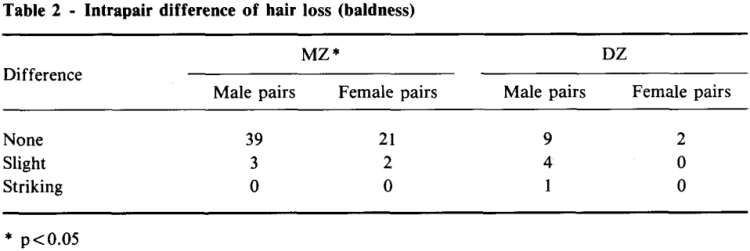
As can be seen in the table, the difference was pretty much nonexistent in almost all monozygotic pairs, whereas slight differences could be observed more frequently in the dizygotic twins, and even a striking difference in one pair. To express this in numbers, the authors calculated the intrapair concordance rate. Which is basically a fancy word for the rate at which a trait is identical between twins. The intrapair concordance rate on hair loss was 92.3% in the monozygotic pairs, and 68.7% in the dizygotic pairs. Since monozygotic pairs have virtually identical genes, whereas dizygotic pairs only share 50%, this implies a considerable genetic component in the development of hair loss. Let’s just say the word androgenetic in androgenetic alopecia is justified.
How does androgen-induced hair loss actually work?
To answer this question, we’ll have to look at how hair growth works. Hair grows in cycles: “hair-follicle cycling” [5, 6]. And these cycles can be subdivided into three phases or stages:
- Growth (anagen phase)
- Involution/regression (catagen phase)
- Rest (telogen phase)
The anagen phase determines how long a hair strand will become. During this phase, a new hair strand will grow. It grows by virtue of extensive proliferation of the so-called hair matrix cells. These are a bunch of cells that are found right on top of the dermal papilla that’s located at the base of a hair follicle. The dermal papilla has a rich blood supply to provide the nutrients required for this process of extensive cell proliferation. Or in other words: there’s a population of cells at the base of a hair follicle which are continuously dividing, adding to the growing hair strand and pushing it upwards. At the start of the anagen phase, it will push out the old hair strand (if still present). The complete anagen phase usually lasts a few years for the hairs on top of your head.
Following the anagen phase is the catagen phase. At the lower part of the hair follicle a lot of cells will die off as a result of apoptosis and the hair strand will be separated from hair matrix cells. The bottom of the hair strand forms a rounded structure referred to as the hair club. From this point forward it cannot grow anymore and it’s just waiting to fall out. Either by a bit of force, or during the next anagen phase when a new hair strand will push the old one out. This phase lasts about two weeks.
Finally, the hair follicle enters the telogen phase or rest phase. At this point, essentially nothing happens till the anagen phase hits it off again. Normally, this phase lasts about 3 months.
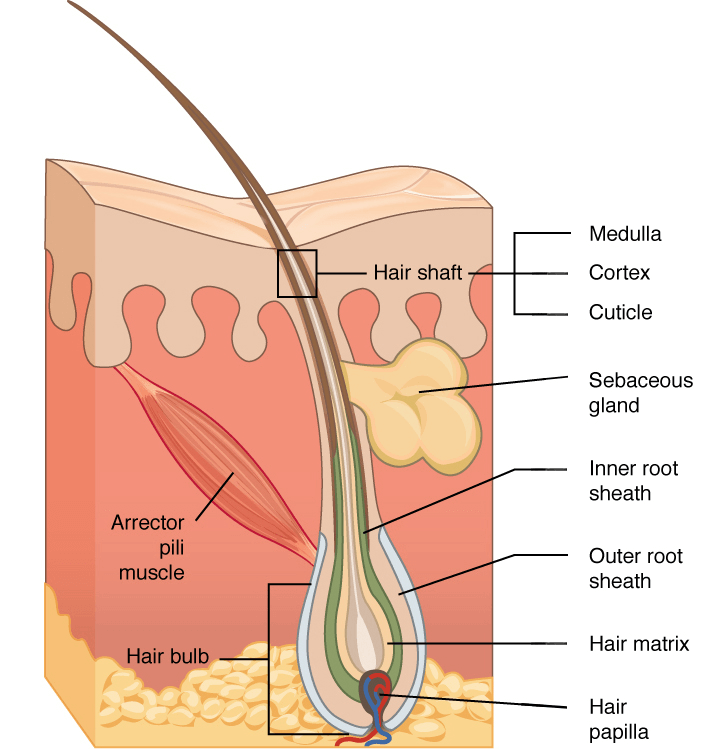
A picture probably makes the above soup of words a bit easier to follow. Let’s go over it briefly again. At the bottom you see the hair, or dermal, papilla. It has a rich blood supply so it can cover the nutrient requirements for the development of hair which continuously takes place during the anagen phase by the hair matrix. A population of cells that sit right on top of it. They produce the cells for the hair strand that will accumulate a lot of hard keratin and eventually die off, and the cells surrounding the hair strand (the inner and outer root sheath). Additionally you can see the sebaceous gland at the top right that adds sebum to it, which will move along up to the skin surface. On the left you see a small muscle that can pull a hair upright (which happens with goose bumps). The area where this muscle attaches is called the bulge. During the catagen phase there’s this process called “involution” going on at the base, right under the bulge, of the hair follicle in which a bunch of those supporting cells die off (apoptosis) and the hair strand gets cut off from the hair matrix.
And here’s another picture roughly describing these phases:
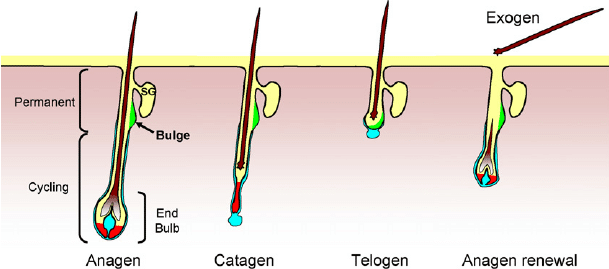
So now we’ve covered all these basics: what’s the effect of anabolic steroids on this? Without touching on the signaling pathways (oh god it are so many): they decrease the length of the anagen phase and increase the length of the telogen phase in selected hair follicles [7]. With each successive hair cycle, the anagen phase continues to decrease in length and the telogen phase continues to increase in length. As a result, at any given moment in time, there will be more hair follicles in the telogen phase—with easily sheddible hairs—and less hair follicles in the anagen phase. Thus, less hair strands will reach out of the scalp in such an area. At some point, the anagen phase can become so short in duration, that a new hair strand barely reaches the surface of the skin.
Moreover, androgens induce something called miniaturization [8]. The hair follicle becomes progressively smaller, and so does the hair shaft and resulting hair strand. The terminal hairs (which are the normal hairs on top of your head), turn into vellus hairs. Vellus hairs are very short hairs that are soft and lack pigment.
Treatment options aim at arresting, or preferably reversing, this progression of miniaturization and disruption of the hair follicle cycle. To date, only two pharmaceuticals for androgenetic alopecia have been approved by the Food and Drug Administration (FDA). The first drug to be approved was topical minoxidil, back in 1988. This drug (or at least the oral version of it) wasn’t specifically developed for this indication. They simply got lucky as they noticed a lot of hypertension patients developed hypertrichosis (abnormal hair growth) and indeed many showed reversal of baldness [9].
The second approved drug targets the enzymes (5α-reductase) responsible for conversion of testosterone into the more potent androgen DHT. This is a drug called finasteride, which is currently only approved for oral use. It was approved for the treatment of androgenetic alopecia in 1997.
Now I hear you thinking: the most recent drug approved for androgenetic alopecia got approved in 1997? Yep. While a tremendous amount of knowledge has been gained about the hair follicle cycle and how androgenetic alopecia develops since then, no new drug has made it to market. Yet. There are quite some treatment options in the pipeline of pharmaceutical companies, however. Some less novel (topical finasteride) than others (e.g. SM04554, a Wnt pathway modulator). With some luck we’ll be seeing some of these new pharmaceuticals obtaining FDA approval in the foreseeable future.
In my next article I will discuss the two FDA approved treatment modalities in more detail, as well as some other treatment modalities that are in the pipeline.
References
- J. B. Hamilton. Male hormone stimulation is prerequisite and an incitant in common baldness. American Journal of Anatomy, 71(3):451–480, 1942.
- Imperato-McGinley, Julianne, et al. “Steroid 5α-reductase deficiency in man: an inherited form of male pseudohermaphroditism.” Science 186.4170 (1974): 1213-1215.
- Imperato-McGinley, Jullianne, and Y-S. Zhu. “Androgens and male physiology the syndrome of 5α-reductase-2 deficiency.” Molecular and cellular endocrinology 198.1-2 (2002): 51-59.
- Hayakawa, K., et al. “Intrapair differences of physical aging and longevity in identical twins.” Acta geneticae medicae et gemellologiae: twin research 41.2-3 (1992): 177-185.
- Paus, Ralf, and George Cotsarelis. “The biology of hair follicles.” New England journal of medicine 341.7 (1999): 491-497.
- Alonso, Laura, and Elaine Fuchs. “The hair cycle.” Journal of cell science 119.3 (2006): 391-393.
- Lolli, Francesca, et al. “Androgenetic alopecia: a review.” Endocrine 57.1 (2017): 9-17.
- Whiting, David A. “Possible mechanisms of miniaturization during androgenetic alopecia or pattern hair loss.” Journal of the American Academy of Dermatology 45.3 (2001): S81-S86.
- Zappacosta, Anthony R. “Reversal of baldness in patient receiving minoxidil for hypertension.” The New England journal of medicine 303.25 (1980): 1480-1481.
About the author
Peter Bond is a scientific author with publications on anabolic steroids, the regulation of an important molecular pathway of muscle growth (mTORC1), and the dietary supplement phosphatidic acid. He is the author of several books in Dutch and English, including Book on Steroids and Bond's Dietary Supplements.
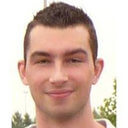
Leave a Reply
You must be logged in to post a comment.